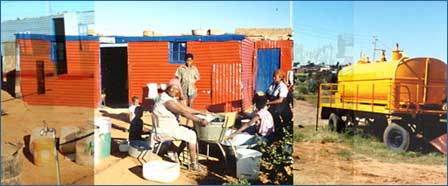|

|
 |
|
 |
ESTABLISHING PRICING POLICY
Pricing of water and sanitation is based on depreciation, operation and maintenance costs, re-investment and profit. Lifeline or social block tariff systems are often used to protect the poor but fail to consider high cost of water. Informal service suppliers and private investment or NGO or donor programmes may not take account of ownership of infrastructure and distribution. Cross-subsidies are often limited by lack of sufficient higher-income consumers.
|
 |
Establishing Pricing Policy
|
 |
How to set prices for services in low-income communities? |
|
ESTABLISHING FINANCING MECHANISMS
Financing is perceived as a high-risk because of low credit-worthiness. Outside financing by NGOs, communities and private sectors often have unclear sustainability arrangements and poor construction and management. Lack of recognition, small-scale and poorly developed distribution networks further discourage investors. Separation of responsibility between water and sanitation utilities reduce opportunities for cross-subsidation.
|
 |
Establishing Financing Mechanisms
|
 |
How can practitioners overcome the problems of finance for investment? |
|
SETTING-UP PAYMENT SYSTEMS
Payment systems must coincide with community income cycles. Large bills, and poorly sited payment points also contribute to low settlement of bills. Vendors or tap attendants are rarely unpaid but indirect payment mechanisms have proven to be problematic: lack of meters and flat rates, and collection via landlords led to dissatisfaction and low payment. Lack of insurance against defaulters discourages a house connection policy and increases risk to utility.
|
 |
Setting-Up Payment Systems
|
 |
How to improve collection rates? |
|
|
|

